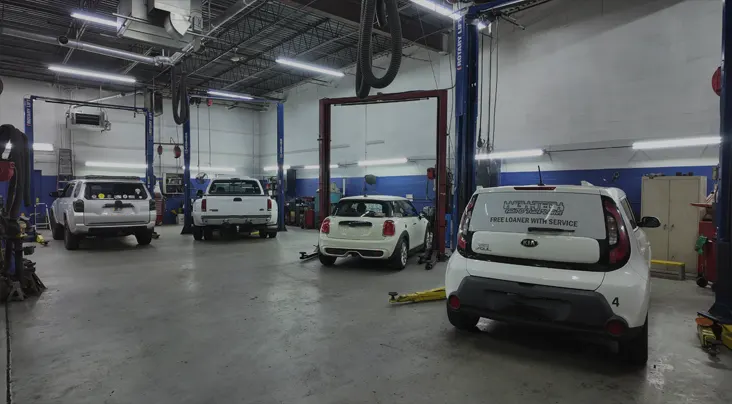
Archive for September 2025The Light Nobody Wants to See (Check Engine Light)Posted September 28, 2025 3:57 AMYou've probably had your Check Engine Light go on. Then it goes off and you figure, hey, whatever the problem was, it's gone now and I don't have to worry about it. Well, the problem may have gone away and it may not have. Your vehicle likely has one of these warning lights on the instrument panel: an amber light that looks like an engine or reads "Check Engine" or "Service Vehicle Soon." If that light comes on and stays on, it usually means there's something amiss but not urgently in need of service. (Now if it's blinking, that's another story that we'll deal with in a minute.) Sometimes when it comes on and stays steadily lit, the problem will go away and the light will go out. Sometimes it will stay on until you get the problem fixed. Either way, the engine's computer will store a code that can provide clues to what's not working—or wasn't working—the way it's supposed to. If you are just dying to know what that code is, you can buy a little code reader or take your vehicle to an auto parts store and they'll read it. Problem is, the code offers so many options that unless you are a trained technician, you probably won't have a clue what those codes mean. So if you want to be sure, take it to your vehicle repair facility and have them check it. Technicians are trained to decipher the codes and, using their experience and other diagnostic equipment, can get to the root of the problem and fix it. As we mentioned before, if that Check Engine light comes on and is blinking, it means a more serious engine malfunction that can damage expensive components such as the catalytic converter and even the engine itself. It's important to have that checked by a professional as soon as possible. High-Tech Auto and Truck Center Busted! Air Conditioning (Air Conditioning Maintenance)Posted September 21, 2025 3:59 AMYour vehicle's air conditioning is something you count on when the weather heats up. But there's bound to be a day when you turn it on and one of these things happens:
Some people are tempted to try to make the diagnosis—and the repair—on their own. They think it's just run out of refrigerant and they can pick up a can at a local auto parts store and re-charge it. If only it was that easy. A vehicle's air conditioning system is complex and made up of many parts. A compressor, evaporator, condenser, tubing, hoses, sensors, valves… the list goes on and on. Each of these components could be the reason for the problem. It could be a leak that's letting the refrigerant escape, but simply re-charging the system hasn't fixed the problem. You have to find the source of the leak and fix it. Service facilities have a device called a "sniffer" which can sniff out refrigerant chemicals. And they can use black light to locate refrigerant that has an ultraviolet dye in it. But often other components wear out; blower motors go bad, resistors blow, tubes clog, compressors fail. And diagnosing that takes training and special equipment you'll find at your service facility. One other thing to keep in mind. It's always better to catch any problems in the air conditioning system before it fails. Ask your service advisor about having the A/C checked as part of the vehicle's maintenance. That's the cool way to go. High-Tech Auto and Truck Center Rotation Explanation (Tire Rotation Patterns)Posted September 14, 2025 3:57 AMYou may notice that when you get your vehicle's oil changed, your service adviser may recommend that you have your tires rotated at the same time. The reasons are simple. That will allow your tires to wear more evenly and reduce the noise your tires make as you drive down the road. There are different ways of rotating tires. If your vehicle has non-directional tires and the same size wheels at each corner, here are the different rotation patterns. For all-wheel drive and rear-wheel drive vehicles, one is called the rearward cross pattern. The rear tires are moved to the front and stay on the same side of the vehicle, and the front tires are moved to the rear on the side opposite of where they were on the front. For all-wheel and four-wheel drive vehicles, use the X pattern. The rear tires are moved to the front on the opposite side of the vehicle, and the fronts are moved to the rear on the opposite side of where they were on the front. For front-wheel drive, there's the forward cross. The front tires are moved to the rear wheels on the same side of the vehicle as they were on the front and the rear tires are moved to the opposite side of the vehicle than they were on the rear. If you have directional tires (they only can be mounted in one direction) and the same size directional wheels, the rear tires are moved to the front on the same side of the vehicle where they were, and the front tires are moved to the rear on the same side they were on the front. And if you have tires with different sizes of non-directional tires and wheels on the front and rear, rotation will be from one side of the vehicle to the other. If you have a spare, it's put into the rotation using a forward cross or rearward cross. Yep, that's a lot to keep straight. So, we suggest letting your service advisor recommend the right rotation pattern for you at the interval your vehicle's manufacturer specifies. High-Tech Auto and Truck Center Visibility Disaster! (Windshield Washer Pump Replacement)Posted September 7, 2025 4:08 AMLet's say you live in a cold climate where the snowy, icy weather challenges you to clear the salt and debris tossed up on your windshield. You push your windshield washer switch expecting a good stream of fluid so the blades can wipe the glass clean. Yet nothing comes out. Nada, zip. What's going on? You know you filled up the windshield washer reservoir within the last week or so. Well, there could be a few things causing your windshield washing system to fail. One culprit? The hoses that are supposed to carry that fluid from the washer pump to the spray nozzles may be frozen, or maybe they're cracked and leaking. It could be the nozzles themselves are stopped up, either iced up or jammed full of debris. Your windshield wiper/washer switch could be worn out or the electrical system may not be conducting power to the washer pump. It's important that this system work properly, especially on days when the sun may be in front of you and your windshield is covered with a cloudy, icy mess. Seeing what's going on in front of you may be like trying to peer through frosted glass, and that's not a safe situation for you or the drivers around you. You need to have this checked out by a technician as soon as you can. Let's say the technician discovers it's not any of those components. Turns out it's the electric windshield washer pump itself that's failed. After replacing it, everything is working fine, and you can see again. As so often is the case with today's complex vehicles, figuring out the root cause of a problem can be tricky. Rely on your vehicle service facility since they have the know how and diagnostic equipment to make sure your view of the road will always be crystal clear. High-Tech Auto and Truck Center | ||
SearchArchiveDecember 2024 (16)January 2025 (4) February 2025 (4) March 2025 (5) April 2025 (4) May 2025 (4) June 2025 (5) July 2025 (4) August 2025 (5) September 2025 (4) October 2025 (4) November 2025 (5) December 2025 (1) | CategoriesBrake Service (2)Engine Air Filter (1)Fuel Filter (1)Service Intervals (2)Dashboard (1)Spark Plugs (1)Timing Belt (1)Alternator (1)Safety (1)Exhaust (3)Fuel Economy (3)Tires and Wheels (1)Older Vehicles (1)Battery (1)What Customers Should Know (19)Cabin Air Filter (1)Drive Train (1)Tires (3)Brakes (2)Alignment (1)Inspection (1)Air Conditioning (4)Trip Inspection (1)Fuel System (1)Keys to a long lasting vehicle (1)Customer Detective Work (1)Steering (2)Oil Change (1)Tire Rotation and Balancing (1)Check Engine Light (1)PCV Valve (1)Differential Service (1) | |
What Our Customers Say
I have had two wonderful experiences here recently (amongst great things to say from my family who are long time customers). High tech is transparent, efficient at assessing vehicle concerns, and addressing problems with your car. Their prices are fair and they do high quality work. I will not go anywhere else in the area.
Read more >~ sarah steppling, 10/27/2025


High-Tech Auto and Truck Center
4007 Westfax DrSuite D
Chantilly, VA 20151
Serving Areas
High-Tech Auto and Truck Center
4007 Westfax DrSuite D
Chantilly, VA 20151









